Welcome to the official website of Shenzhen Yinsu Intelligent Technology Co., Ltd.
National Service Hotline:+8618927439160 / +86-755-84118220
It can be charged without taking off the smart watch, this research makes people become wires
- Time of issue:2021-08-12
It can be charged without taking off the smart watch, this research makes people become wires
(Summary description)Health monitoring function has gradually become one of the important reasons for everyone to use smart wear. Smart wearable devices need to be removed for charging, which will affect the integrity of the monitored health data. To
Recently, researchers at the University of Massachusetts Amherst in the United States designed a new solution called ShaZam that can be charged without removing the smart wearable device.
- Time of issue:2021-08-12
Health monitoring function has gradually become one of the important reasons for everyone to use smart wear. Smart wearable devices need to be removed for charging, which will affect the integrity of the monitored health data.
Recently, researchers at the University of Massachusetts Amherst designed a new solution that can be charged without removing the smart wearable device, called ShaZam .
The principle of ShaZam involves the Intra-Body Power Transfer (IBPT) technology, which uses the human body as a medium for transmitting power to realize interaction between users and daily objects. Charge wearable devices wirelessly at any time.
The title of the research paper is "ShaZam, a technology for transmitting energy through the human body, using everyday objects to charge smart wearable devices (ShaZam: Charge-Free Wearable Devices via Intra-Body Power Transfer from Everyday Objects), published on June 24 in the proceedings of the International Computer Society (ACM).
Thesis link:
https://dl.acm.org/doi/10.1145/3463505
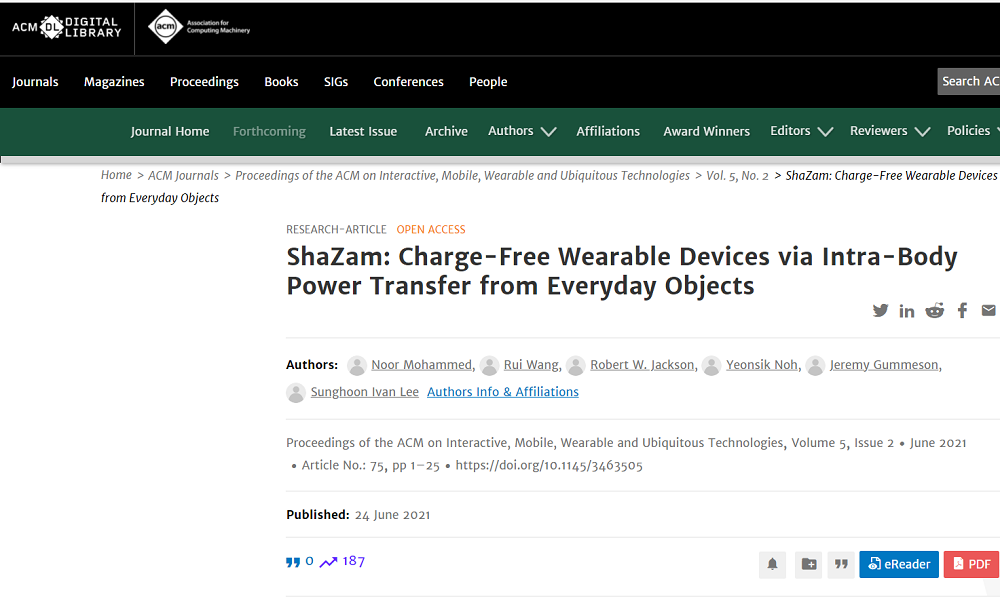
01 Ensure the safety of the human body and allow electrical energy to flow in and out
Although the concept of IBPT was introduced in the 1990s, there are still not many explorations in terms of feasibility evaluation and practical applications. The main technical challenge related to IBPT is to ensure the safety of the human body during the process of current flowing into the human body in the forward direction and out of the human body in the reverse direction.
Inspiration in the field of intra-receptor communication (IBC) (IBC is a technology that treats the human body as a cable and uses a communication device for two-way data communication), using the human body There are two potential solutions for charging. One is the capacitive coupling method that uses the human body as the forward path and uses quasi-static near-field capacitive coupling to establish the signal return path, and the other is the capacitive coupling method that regards the human body as a lossy conductive medium.
In the capacitive coupling method, both the power transmitter and receiver will have an electrode (called a skin electrode) to establish capacitive coupling with the human body and a floating metal plate (Called the ground electrode) establishes another capacitive coupling with the environment in the air (including the parasitic coupling between two ground electrodes).
In this configuration, the time-varying electric field around the human body can be approximated as a uniform phase field, which induces current to flow through human tissues, thereby transferring energy .
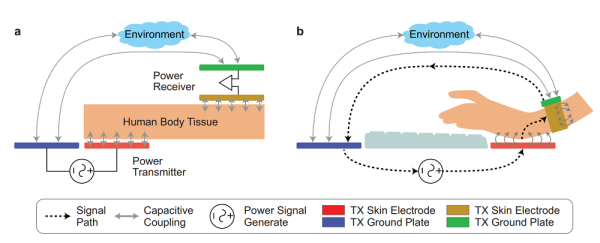
▲Schematic diagram of using the human body to conduct electricity
The ShaZam smart wearable device charging solution developed by researchers from the University of Massachusetts uses this capacitive coupling mechanism, in which the forward circuit is constructed by dry copper material The electrodes allow radio frequency signals to enter the body tissues, and the return circuit is established by the inherent natural capacitance between a pair of copper metal electrodes floating in the air and the surrounding environment.
Researchers have experimented with three different devices (an external keyboard on a desktop computer, a keyboard on a laptop, and a car steering wheel) that conduct electricity through the human body when they come into contact with them. Transfer power to a wrist-worn smart device.
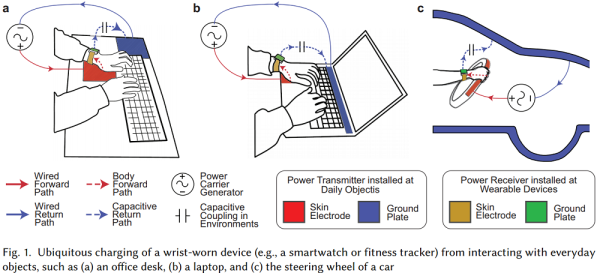
▲Researchers use 3 kinds of daily equipment to conduct experiments
The charging scheme designed by the researchers can currently support ultra-low power health trackers such as Fitbit Flex and Xiaomi bracelets, but it cannot be supported as Apple Watch. This high-power wearable device is charged.
02 ShaZam indicators and equipment are different from other wireless charging span>
In fact, wireless charging is not a new technology anymore. Major mobile phone and smart wearable manufacturers are showing off their wireless charging technology, such as Xiaomi and OPPO released this year They developed their own wireless charging technology.
Wireless charging refers to the use of magnetic induction, magnetic resonance, and capacitive coupling mechanisms to achieve near-field power transmission technology from power to load.
Wireless power transmission methods are roughly divided into two categories: one is the use of antennas that can receive and transmit radio to wirelessly charge the radio frequency for energy transmission, and the other It is the use of instrumented infrastructure to create electromagnetic coupling wireless charging that allows paired devices to establish a coupled electric or magnetic field (specifically, there are two slightly different charging methods: electromagnetic induction wireless charging and electromagnetic resonance wireless charging).
RF wireless charging devices either use dedicated transmitters/receivers for periodic power transmission, or collect power from environmental wave sources (such as television or radio stations).
Like Xiaomi’s air charging, the air charging pile will have a phase interference antenna for spatial positioning of the device, detecting the location of the device, and a phase control antenna array , The millimeter wave is directionally transmitted to the device through beamforming. The equipment end is equipped with a beacon antenna to broadcast equipment location information in the space field, and the millimeter wave signal transmitted by the charging pile by the receiving antenna array is converted into electrical energy through a rectifier circuit.
Electromagnetic coupling wireless charging technology research, more research focuses on capacitive and inductive transmission modes, which generate electric or magnetic fields in a large room, allowing devices to obtain through field coupling power. Although more energy-efficient than antenna-based charging systems, a lot of infrastructure changes are required to ensure that electric or magnetic fields can cover the required area everywhere.
Nowadays, many smart watches mostly use this electromagnetic coupling wireless charging method. These devices will use the wireless magnetic circuit of the magnetic field to replace the wired wire to realize the transmission of power. When charging, both the charger and the device to be charged must have coils, and the coils of the two must be aligned and can work normally at a very close distance (touch).
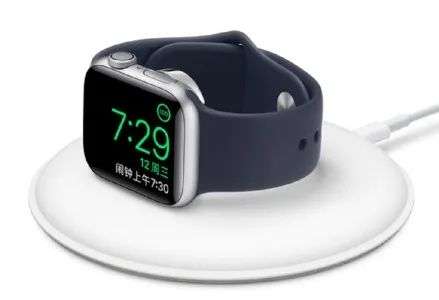
Need to align coils, distance limitation, and the number of charging devices are three items that limit the development of electromagnetic induction wireless charging. For example, Huawei’s HUAWEI WATCH 3 manual introduces that it is necessary to ensure that two aspects are correctly operated for smooth and safe charging. One is to “ place the watch on the charging base so that the back of the watch is attached to the charging base, and adjust the fit until Charging instructions appear on the watch screen. The second is that when wireless charging, please use a dedicated base and make sure that the coil is directly facing.
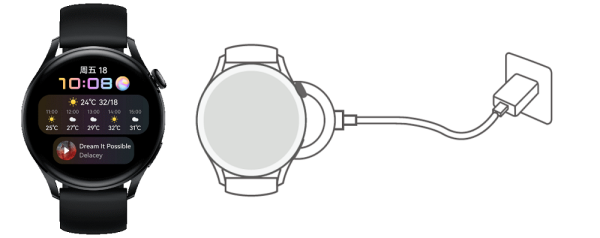
Electromagnetic resonance wireless charging technology has lower requirements for location and distance, which helps solve problems such as charging location and charging quantity. For example, OPPO’s air-to-air charging technology released this year uses electromagnetic resonance to transfer energy. Even if the coil positions of the transmitter and receiver do not match, the charging can be maintained.
The ShaZam smart wearable device charging solution combines radio frequency wireless charging, electromagnetic induction and electromagnetic resonance wireless charging. They all use electromagnetic principles for charging. The difference lies in them. The dielectric used is different. Dielectrics can be divided into free space, man-made infrastructure, human tissue, and so on. However, it is necessary to pay more attention to its safety through human tissues.
The ShaZam solution uses different dielectrics, and the design of its equipment and indicators is quite different from common wireless charging methods.
The working principle of the IBPT included in the ShaZam projectStrictly limit the transmission power of the human tissue directly coupled to the transmitter and receiver, thereby minimizing the size of the transmitter and the loss of the human body medium.
03 Wireless charging needs to consider the impact on other devices< /span>
The safety of near-field wireless charging is a key consideration. Especially in the high frequency (HF) range, the incident time-varying electromagnetic field (EMF) wave will generate displacement current through the human tissue (that is, the time change of the electric field in space), which may cause thermal damage to the tissue, so it is necessary to The operating frequency is limited.
Another problem with radio frequency wireless charging exposure is electromagnetic interference to active/passive medical implants and the impact on equipment that also uses radio frequency.
In the "Interim Provisions on Radio Management of Wireless Charging (Power Transmission) Equipment (Draft for Comment)" issued by the Ministry of Industry and Information Technology in February this year, there are relevant content regulations, mentioning In order to protect the radio astronomy business and ensure the safety of the use of special radio frequencies for ships and aircraft, it is prohibited to use wireless charging equipment within the protection distance of radio astronomy sites and in ships and aircraft.
How to solve or reduce these effects is also something to be considered for smart wearable wireless charging.
04 Conclusion: User needs drive design changes
From a technical level, it has become a reality to charge smart wearable devices through the human body, but the safety test is still relatively simple. The number of volunteers participating in the experiment is not large, and some data Not yet representative. But the next stage of progress for using the human body for dielectric charging has laid a solid foundation.
A smart watch produced by Jiaming is equipped with a solar charging function, and MATRIX’s PowerWatch has a charging function using human body heat. These may be more inclined to outdoor smart watches , Various manufacturers are also studying whether there are more ways to charge smart devices and wearables.
National Service Hotline
+8618927439160
Phone:+8618138419185 / +8618927439160
Tel:+86-755-84118220
Mail:yinsukj@163.com
Address: Room 404, Longsheng Times Building, Gongye West Road, Longsheng Community, Dalang Street, Longhua District, Shenzhen
Official Account

Customer Service







